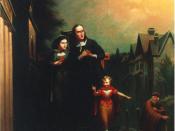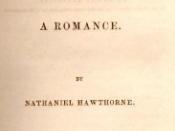In the 1600's, while searching through a dusty room in the Custom House in Salem, Massachusetts, Nathaniel Hawthorne came across a piece of red fabric and several pages written about a woman of humiliation and shame. With these few pieces of evidence and a knowledge of how it could have been, Hawthorne wrote his novel The Scarlet Letter, a religious and psychological allegory about a lustful sin in Colonial Boston and the years that follow. Like all allegories, the novel uses symbols, such as little Pearl as the living scarlet letter, to develop and add meaning to the story. Pearl's relationship with her mother, Hester Prynne, and the hidden relationship with her father, Arthur Dimmesdale, have several purposes and give Pearl important roles throughout the story. This is shown in her position as the living scarlet letter, the supposed demon-child, and an angel of judgment of both her parents.
The most evident symbol Pearl represents is the scarlet letter itself. The letter is embroidered with "flourishes of gold-threadâ¦and withâ¦gorgeous luxuriance of fancy" (p. 53). In the same way that the letter is beautiful, Pearl is described, even at such a young age, as having "a native graceâ¦coexist[ing] with faultless beauty" (p. 91). Aside from the common natural splendor, Hester actually dresses Pearl to resemble the scarlet letter. Pearl's garb consisted of "a crimsonâ¦tunicâ¦abundantly embroidered withâ¦flourishes of gold-threadâ¦.Hester [had] contrived [it] so perfectly to represent the scarlet letter in [Pearl's] appearance" (p. 103). Not only are there physical similarities between the child and the letter, but their very meaning and the passion they both represent are similar as well. Pearl's name implies that she was "of great price,--purchased with all [Hester] had,--her mother's only treasure!" (p. 89) Pearl had been given to Hester by God in exchange for...


